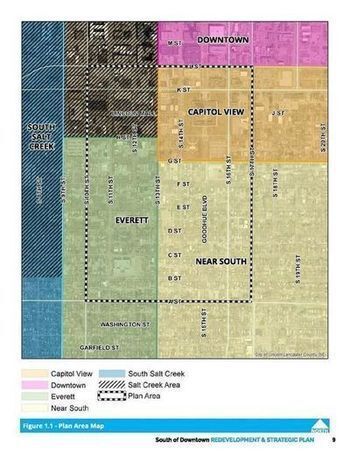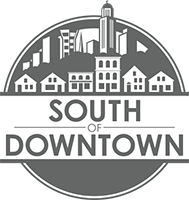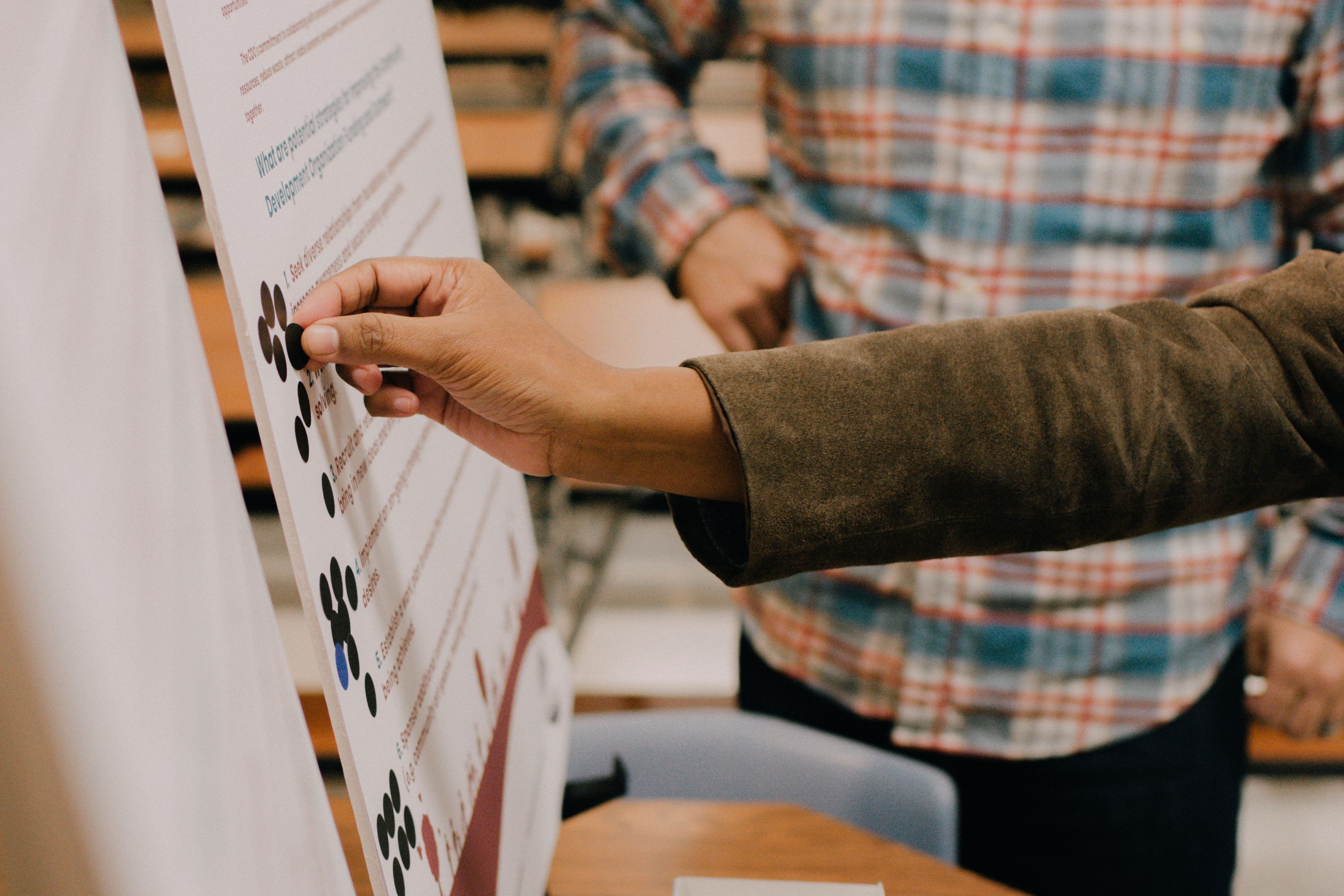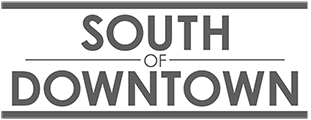South of Downtown Redevelopment & Strategic Plan
The South of Downtown Redevelopment & Strategic Plan is a city plan that sets the foundation for future public and private investment in the South of Downtown Area (10th to 17th and A to L Streets). This plan is the product of over three years of listening to and with our neighbors about what change they would like to see in their neighborhood, and it is our role at SDCDO to support our neighbors in leading their own change through the implementation of this plan.
Where We Came From
The South of Downtown Community Development Organization (SDCDO) originated from the South of Downtown Revitalization Plan, a gentrification plan that was funded by private investors and tasked with steering wealth-building through property investment. Before SDCDO’s foundation, conversations centered private interest and redevelopment without holding space for the lived experiences of the community. Today, we are far from where we came.
Where We Are Now
Since 2017, SDCDO has recentered around equitable community development in which the lived experiences of our neighbors are the driving force behind everything we do. We have laid a new foundation of Asset-Based Community Development, where the assets of our neighborhoods - our neighbors - are the ones leading the change that they want to see. From our programming being led by and for our neighbors to our board being composed of past and present residents and folks with deep roots in the community, we strive to adopt our neighbors’ hopes and dreams for our shared community as our organizational priorities.
These organizational priorities as community values and goals have been cemented into our public policy through the adoption of the South of Downtown Redevelopment & Strategic Plan (R&S Plan), a city plan that guides future investment in our neighborhoods. This Plan is the result of over three years of deep listening with neighbors at their doorsteps and block parties; with advocacy groups, multilingual parent groups in schools, and neighborhood associations; and in our SDCDO action committees. Even after three years of elevating resident voices, goals, and concerns to our partners in the City of Lincoln’s Urban Development department to guide this plan, we still had work to do. When the draft R&S Plan was released, we held several listening sessions and one-on-one conversations with neighbors. We learned more about the inadequacies of the draft plan and its potential for allowing gentrification and displacement. As a result, the City of Lincoln adopted an amendment to the R&S Plan on gentrification and displacement mitigation, the first formal measure of this kind to be adopted by the City of Lincoln to address systemic poverty.
The South of Downtown Redevelopment & Strategic Plan

The Redevelopment Plan is a guide for the City of Lincoln’s Urban Development department to appropriate public and private funds to rehabilitate blighted areas (e.g., redeveloping dilapidated housing, adding parks and recreation areas, removing congestion, etc.). It identifies physical redevelopment projects and government regulatory processes that lay the groundwork for private investment, and it is governed by state statute.
The Strategic Plan gives us a short-term action plan that includes social and economic issues and strategies, which is led by the community, mostly via the South of Downtown CDO with the city as a partner. This is guided by the Asset-Based Community Development (ABCD) process, which focuses on the existing strengths of the neighborhood, rather than its weaknesses.
"ABCD challenges traditional thought that assumes communities need to be fixed by outsiders. Instead, the approach considers local assets to be the primary building blocks for developing strong, sustainable communities. Residents often have the abilities and power to drive change themselves." (Page 12 of the R&S Plan.)
Strategic Plan Priorities
1. Focus on Problem Properties & Increase Code and Parking Enforcement (Page 73)
- Implementing more-focused code enforcement on unsafe, unhealthy, and improperly maintained properties in the South of Downtown focus area;
- Expanding code enforcement services;
- Creating a registry of vacant properties and properties with records of code violations;
- Increasing parking enforcement.
2: Expand Recreation and Gathering Spaces (Page 74)
- Maximize community learning centers, playgrounds, and green spaces at elementary schools and the F Street Community Center;
- Expand gathering and green spaces;
- Organize more frequent community events;
- Develop/expand intentional collaborative relationships between neighborhood and service providers;
- Develop a plan to preserve healthy older trees and replace them.
3: Expand Economic Opportunities (Pages 76-78)
- Continue the Human Services Subcommittee to foster collaboration among anchor institutions in the community and economic development;
- Promote pathways for economic opportunities;
- Identify and eliminate barriers to employment;
- Expand childcare, especially for folks living in apartment units;
- Repurpose/expand parts of the F Street Community Center to become a hub for information and services and a gateway for the neighborhood, including immigrant neighbors;
- Expand and promote existing programming in the neighborhood and F Street Community Center;
- Create a neighborhood training center for education, healthcare, jobs, childcare, employment training, and more;
- Work more with existing businesses to recruit neighborhood residents as employees;
- Expand public transportation hours and routes;
- Create a health worker training center;
- Ensure access to information and communication technologies and education for all neighbors and commercial users;
- Higher density mixed-use redevelopment and garage parking for blocks between “K,” “L,” 10th, and 14th Streets;
- Expand micro-lending for small businesses;
- Pursue private investors to use Opportunity Zone tax credits;
- Build parking garage(s) for state employees and guests to reduce their strain on the neighborhood parking;
- Develop business incubator spaces.
4: Increase Funding for Housing, Especially Affordable Housing and Workforce Housing (Page 79)
- Identify city funding sources for rehabilitation and redevelopment of properties for rental and homeownership;
- Increase the city’s Affordable Housing Fund;
- Create a Tax Increment District to allow funding to go to affordable housing and the repair/replacement of infrastructure;
- Rehab/redevelop quality affordable housing for folks with 30-80% Area Median Income (AMI) using multiple affordable housing development programs;
- Modify the Lincoln Electric System sustainable energy fund to benefit more rental properties;
- Seek nonprofit and philanthropic funds (e.g., grants and mission investment loans) for project, program, gap funding, and technical assistance;
- Leverage Opportunity Zone tax incentive investments.
5: Increase Safety, Crime Prevention, and Sense of Community (Page 80)
- Use a comprehensive and holistic approach to neighborhood safety and services through community policing for crime prevention and relationship building;
- Increase street, alley, and pedestrian lighting. Use placemaking to add community murals and other public art in alleys and remove overgrown vegetation in public spaces. Map lighting and crime correlation.
- Increase School Neighborhood Advisory Councils (SNACs) in the community learning centers and other school-based programming;
- Determine if the 2015 International Existing Building Code should be adopted;
- Improve key governmental, health, and emergency management systems to disseminate and share key information and to prevent, mitigate, protect, respond, and provide recovery assistance in the event of a disaster in the South of Downtown area.
6: Enhance the Public Right-of-Way (Page 82)
- Increase area lighting and pedestrian scale lighting;
- Improve alley appearances, including lighting, trash collection, and the removal of voluntary trees;
- Identify closer-to-home improvements (e.g., sidewalks, crosswalks, bike lanes, etc.);
- Increase on-street parking in the proposed north PUD (e.g., 11th Street);
- Reduce the digital divide by installing infrastructure to provide affordable hardware and wireless communication.
7: Improve the CDO Funding and Outreach (Page 84)
- Seek diverse relationships from foundations, corporations, and government to increase awareness and secure funding opportunities;
- Recruit and retain high-capacity board members and volunteers to bring in new ideas and energy;
- Implement a never-ending strategic-planning process to build on community assets and identify opportunities;
- Enhance outreach efforts and problem-solving;
- Sponsor additional community gatherings to strengthen community bonds;
- Establish a work plan to ensure that outcome measurements and results are being achieved;
- Increase SDCDO outreach with governmental, health, and emergency management systems, neighborhood businesses, and area nonprofits to prevent, mitigate, protect, respond, and provide recovery assistance in the event of a disaster in the South of Downtown area.
8: Establish and Fund a Community Land Trust (Page 86)
- Establish a Community Land Trust to purchase existing property, parking lots, and vacant properties.
- Acquire parking lots and other available properties to provide mixed-use redevelopment with affordable and market-rate housing and commercial community needs, such as groceries, daycare, social services, etc.
9: Increase Landlord and Tenant Education Programs (Page 86)
- Increase tenant education using multilingual literature and trainings in cultural and community centers;
- Require landlords with repeated violations to take a “STOP” education class or to renew city apartment permits;
- Develop a Supplemental Property Management Training Program;
- Provide language interpreters to Building and Safety;
- Establish legal aid services to provide education on tenant rights.
10: Amend the Zoning Ordinance and Zoning (Page 88)
- Adopt mixed-use Planned Unit Development (PUD) in the north part of the area (residential + office + retail + restaurants + technology);
- Amend zoning to allow construction and redevelopment of affordable housing on non-conforming and nonstandard lots;
- Expand allowable home occupation square footage - more in the PUD and less in the balance of the South of Downtown area.
The Strategic Plan is a tool that we are using to amplify resident-led change, and it’s about more than just economic development. It’s about community development - investing in our neighbors, small business owners, creative entrepreneurs, and everyone in-between so that all our neighbors have equitable access to the tools and resources they need to thrive. We know from listening that not all of our neighbors have this access and that they face barriers due to faults in our city policies. The R&S Plan seeks to remedy these faults.
The South of Downtown focus area, which is from 10th to 17th and A to L Streets, is home to some of the most vibrant and diverse neighborhoods in Lincoln. It is also home to the greatest concentration of renters, who are the most significantly impacted by shifts in housing practices and policies. This is no doubt a large focus of the plan because housing affordability, accessibility, and adequacy are some of what we hear the most from our neighbors when we ask what change they would like to see in their neighborhood. This is why we have started to craft affordable housing tools, such as the Community Land Trust, and implement them right here in our neighborhoods.
All of the priorities in the Strategic Plan are goals that our neighbors have set and that we have already been working on together to achieve. From increasing neighborhood safety through alley paintings and mental health crisis response education, to supporting our neighborhood entrepreneurs with physical and virtual makers markets. If you’d like to get involved in implementing any of the priorities in the R&S Plan, send us a message! We’d be happy to start dreaming and scheming together.


